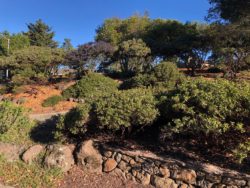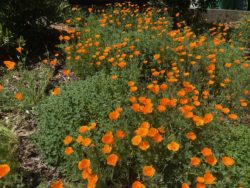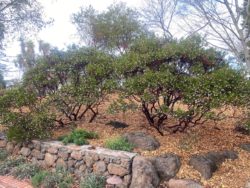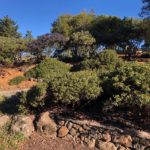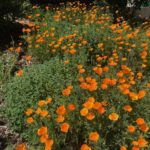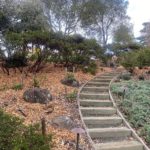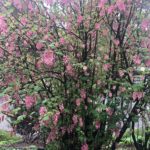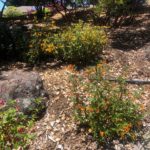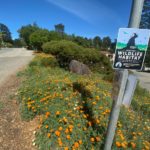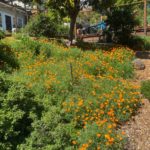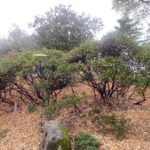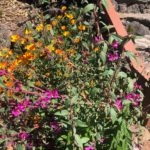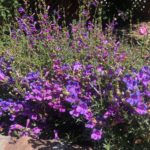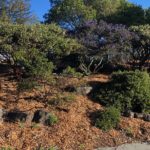Lot size:
Garden Age:
Years on the Bringing Back the Natives Garden Tour: New this year!
Showcase Feature
Wendy’s spacious lot in the Oakland hills was designed to be productive—for both wildlife and people. Wendy, an organic gardener who has been referred to as “a rabid recycler and an extreme composter,” is also an impassioned restorationist at heart: creating habitat for wildlife in her own garden by planting California natives, and restoring habitat for wildlife in several Oakland parks.
“I’m a big Doug Tallamy fan,” reports Wendy, “and his book changed the way I look at our garden. We don’t use herbicides or pesticides. We control weeds with mulch, and we plant natives to create habitat for wildlife.” Mature oaks, manzanitas, and California lilac, all keystone species—plants upon which numerous species of butterflies and moths can lay their eggs—grace this hillside garden, delighted winged and bipedal visitors alike.
Wendy spends much of her time in retirement doing what she calls “advanced gardening” as an environmental restoration volunteer in several parks in the Oakland hills.
Primarily, she works with the Friends of Sausal Creek, removing invasives and planting natives in two open space parks. This work has been transformative in Beaconsfield Canyon, which used to be filled with weeds and trash. Thirteen years later, it is more like a nature preserve with meadows of native grasses and forbs. Monthly work parties maintain the planted areas – weeding and pruning trees and shrubs to reduce the fire danger.
In Reinhardt Redwood Regional Park, Wendy has volunteered for 15 years pulling highly invasive—and highly flammable—French broom. Removing broom has opened up the forest edges and meadows allowing native grasses, wildflowers and other plants to flourish.
The resulting resurgence of native flora and fauna is deeply satisfying to Wendy, who values this opportunity to give back. “These small parks provide critical habitat for wildlife and are our last preserves of our local native trees and plants,” she notes. “They are treasures, really, but are often unmaintained and overgrown unless volunteers step in.”
To join restoration efforts with the Friends of Sausal Creek , go to: https://www.sausalcreek.org/event-calendar
For information on volunteering with the East Bay Regional Parks, go to: https://www.ebparks.org/about/getinvolved/volunteer/operations.htm
- In Wendy’s own garden, a large, high performance organic vegetable garden provides most of the produce the family consumes during the summer and fall.
- Two 500-gallon cisterns store rainwater.
- Drainage from rain gutters has been diverted into the yard, rather than into the storm drains
- The garden is heavily mulched to save water, suppress weeds, and enrich the soil.
- A legal graywater system recycles water from two showers into the garden
- Stone terracing and stones placed throughout the garden as accents create useable garden space, and provide visual interest.
The oaks, manzanitas, and other native shrubs and grasses provide food, shelter and nesting areas for bees, butterflies and birds. Wendy’s garden has been certified by the National Wildlife Federation as a Wildlife Habitat Garden.
Video of Wendy Tokuda’s garden
Video of Wendy Tokuda’s garden


